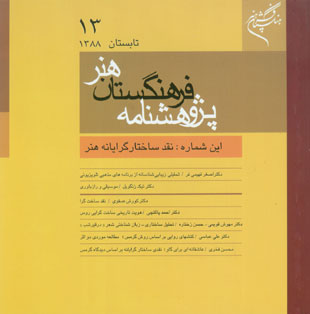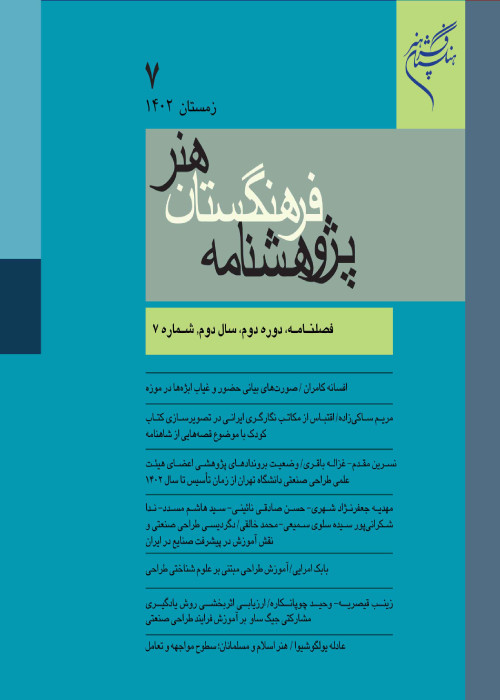فهرست مطالب

پژوهشنامه فرهنگستان هنر
پیاپی 13 (تابستان 1388)
- 168 صفحه، بهای روی جلد: 35,000ريال
- تاریخ انتشار: 1388/06/25
- تعداد عناوین: 9
-
صفحه 5
- بخش اول:اصول و مبانی نقد و پژوهش هنری
-
صفحه 7
در این مقاله بناست با اتکا به ادبیاتی فلسفی و زیبایی شناختی در حوزه رسانه به تجزیه وتحلیل دسته ای از برنامه های مذهبی تلویزیون بپردازیم. بر این اساس، ضمن آسیب شناسی برخی از برنامه های ساخته شده از مراسم دعا و نیایش و مقایسه آن با نمونه های خارجی، تلاش می کنیم تا حد امکان پیشنهادهایی برای بهتر ساخته شدن این گونه برنامه های مذهبی ارائه دهیم. سوال اصلی نوشتار حاضر این است که آیا برنامه سازان تلویزیونی توانسته اند از همه ظرفیتهای زیبایی شناختی تلویزیون برای تلویزیونی کردن محتوایی دینی، یعنی «دعا» بهره برداری کنند؟
کلیدواژگان: برنامه تلویزیونی، فناوری، دین، ساختار، ترکیب بندی، معناسازی -
صفحه 29
موسیقی رازناک به نظر می رسد و تجربه ما از برخی انواع آن می تواند ژرفای خاصی داشته باشد. نگارنده معتقد است که باید پذیرای این رازناکی شویم و در پی بی اهمیت جلوه دادن آن نباشیم. موسیقی و تجربه ما از آن به گونه ای است که با اصطلاحات تحت اللفظی قابل توصیف نیست. در اینجا دیدگاهی را درباره موسیقی مورد بررسی و مداقه قرار می دهیم که بی پروا رازباورانه است؛ هرچند این رازباوری صورت ویژه ای به خود می گیرد.
کلیدواژگان: موسیقی، رازباوری، خدا، ژرفناکی، وصف ناپذیری - بخش دوم: نقدنامه
-
صفحه 39
-
صفحه 56
این نوشتار به بررسی نقد ادبی از دیدگاه ساخت گرایی اختصاص یافته است. مولف برای دستیابی به این هدف، نوشته حاضر را به چند بخش تقسیم و هر بخش را با پرسشی آغاز کرده است تا به این نکته بپردازد که اصولا در یک نقد ساخت گرا باید به دنبال چه مولفه هایی بود، یا این که نقد ساخت گرا در شکل آرمانی اش چه می تواند باشد. بخش پایانی مقاله به معرفی الگویی پیشنهادی اختصاص یافته است که به نظر مولف، می تواند الگوی تازه ای برای نقد ادبی از منظر «زبان شناسی ساخت گرا» باشد.
کلیدواژگان: ساخت گرایی، زبان شناسی، نظام زبانی، الگوی نقد -
صفحه 75
«ساخت گرایی» عنوانی است برای نوعی طرز فکر درباره موضوع علوم انسانی که بیش از آن که با وجه جامعی شناخته شود، با فرد اجلای خود، سوسور و ساخت گرایی فرانسوی شناخته می شود. در مروری بر جریانهای فکری سده اخیر در روسیه، این پرسش پیش روست که با توجه به نقش تعیین کننده زبان شناسان روس به عنوان پیش قراولان الگوی سوسوری و نقش سازنده متفکران مهاجر روس در شکل گیری ساخت گرایی چک، تا چه حد اندیشه ساخت گرا در روسیه زمینه داشته و پس از حاکمیت ایدئولوژی مارکسیسم لنینیسم در چه بستری امکان دوام یافته است. آن گاه که سخن از عصر فعالیت شکل گرایان است، هنوز عنوان ساخت گرایی پای به عرصه ننهاده و آن گاه که سخن از مابعد استیلای شوروی است، هیچ طرز فکری نمی تواند این نام را بر خود بنهد.
آنچه پیجویی جریان ساخت گرا در روسیه را دشوار می سازد فاصله ای است که از اندیشه سوسوری در عدم گریز از مطالعه درزمانی و پویاانگاشتن ساختار و اهمیت دادن به خلاقیت فردی گرفته است. در مقاله حاضر کوشش شده است تا نخست مولفه های ساخت گرایی با توجه به تحولات پساسوسوری بازکاوی شود و با پیجویی این مولفه ها در محیط روسیه، جریان ساخت گرایی روس بازشناخته گردد. در این کاوش، سخن از جریانهایی است که خود، خویشتن را با عناوینی دیگر خوانده اند و جز در دهه های اخیر از سوی ناظران، ساخت گرا خوانده نشده اند.کلیدواژگان: ساختار، ساخت گرایی، روسیه، شکل گرایان، مورفولوژی، مکتب مسکو، تارتو -
صفحه 101
تحلیل ساختاری زبان شناختی یکی از اولین رویکردهای پربار نقد نو است که با بهره گیری از رهاوردهای علم زبان شناسی و بی توجه به عناصر خارجی، به مطالعه متن می پردازد. سابقه استفاده از چنین رویکردی در تحلیل متن به صورت گریان روس، به ویژه یاکوبسن، برمی گردد که سپس ساختارگرایان و روش های نوین مطالعه متن از آن بهره می برند. مقاله کنونی نیز با به کاربردن این رویکرد، درنظر دارد تا علاوه بر نشان دادن کارایی چنین روشی، با مطالعه عناصر متنی یکی از اشعار سهراب سپهری، خوانشی متفاوت از آن ارائه دهد.
کلیدواژگان: عنوان، ساختار، توازن، تکرار، آراینه های ادبی، قافیه -
صفحه 115
هدف از این مقاله نشان دادن روش گرمس، یکی از اندیشمندان ساخت گرای مکتب نشانه معناشناسی پاریس است که به خصوص بر ساختار روایتها تاکید کرده است. در این مقاله، ابتدا ساختار روایی روایت را از نظر گرمس معرفی خواهیم کرد و درصدد پاسخ به این پرسشها بر خواهیم آمد که: روایت چیست؟ و روایت حداقل کدام است؟ به صورت موردی ساختار روایی و پیرنگ را در کتاب آواره بی خورشید، بررسی کنیم و سپس به این پرسش اساسی پاسخ گوییم: آیا این کتاب یک روایت است؟ و آیا از منطقی منسجم (انسجام درونی) پیروی می کند و چرا؟ آیا در این اثر یک الگوی ثابت (سه پاره ابتدایی، میانی و انتهایی) وجود دارد؟ آن گاه در بخش دوم تلاش خواهیم کرد به تحلیل ساختاری یک اثر نقاشی با بهره گیری از نظرات گرمس بپردازیم.
کلیدواژگان: گرمس، روایت، پیرنگ، روایت حداقل، ساختار روایی، انسجام درونی -
صفحه 136
این مقاله بر آن است تا با تکیه بر نظریه های ساختارگرایانه و براساس دیدگاه های گرمس، به خوانش فیلم «گاو»، بپردازد. گرمس شکل گیری معنی را اساسا بسته به حضور «قطبهای متضاد» و یا «قطبهای دوگانه» می داند. در مقاله یکی از اساسی ترین قطبها، یعنی تقابل فرهنگ و طبیعت در فیلم بررسی و نشان داده می شود که چگونه تقابل این دو گفتمان بر شکل گیری روند معنی و فرجام اثر تاثیر می گذارد. گرمس همچنین معتقد است که این تقابل در ساختار پیرنگ روایت به واسطه الگوی کنشگران به جلو می رود. از این رو در بخشی از مقاله الگوی کنشگران این روایت ترسیم و کارکرد شخصیتهای داستان در روند شکل گیری معنی با این دیدگاه ساختارگرایانه تشریح می شود.
کلیدواژگان: گرمس، فرهنگ، طبیعت، قطبهای متضاد، الگوی کنشگران
-
Page 7
Depending on a philosophical and aesthetic literature in the realm of media, this article is to analyze a bunch of religious programs on Iran National TV. While carrying a pathological approach to some programs such as worship and prayer, and comparing those programs to the similar ones abroad, the article will try to propose recommendations to produce better programs in this field. The main question that is put forward in this article is whether the TV producers have been able to enjoy and mirror all the aesthetic potentiality of TV in order to place religious concepts such as worships in the frame of TV programs.
Keywords: TV Programs, Technology, Religion, Format, Composition -
Page 29
I outline an ineffabilist view of music and our experience of it. There is a special problem with describing music and musical experience in literal terms. I compare and contrast the problem of describing music and our experience of it first with the problem of describing sensations and then with the problem of describing God. I make a suggestion concerning the apparent profundity of some music.
Keywords: Music, Mysticism, Profundity, Ineffability -
Page 56
This article is devoted to the study of structuralist criticism. In order to achieve the target, the author has divided the article into several parts. Each part begins with a question in order to deal with the idea that what elements are basically supposed to be sought in structuralist criticism or what is a structuralist criticism in its own ideal form. The final part of the article will set forth a proposed model which is, to the author, a new model for literary criticism from the view point of “ structuralist linguistics”.
Keywords: Structuralism, Linguistics, Langue, Critical Model -
Page 75
Structuralism is a name for a trend in human science which is mostly known by its originators- Saussure and French structuralism- rather than the social concept it deals with. Having a view over the last century, we come across this question that since the Russian linguists were pioneers to the Saussurian model, and the immigrant Russian thinkers played a remarkable role in forming the Czech structuralism, how much the ground was prepared for the structuralism to appear in Russia? And after the establishment of the Marxistleninist government how did it manage to survive? When the formalism was prevalent and dominant, structuralism had not been born yet, and when The Soviet Union was in power no trend dared to bear such a name. What makes a research difficult concerning the history of structuralism in Russia is the distance Russian structuralism keeps from the Saussurian synchronic tendency; from regarding the structure as dynamic and emphasizing the personal creativity. This article is trying to first restudy the structuralist elements regarding the post-Saussurian movements. Examining these elements in the atmosphere of Russia, then the article will illustrate the Russian structuralist movement. This research will additionally discuss the movements which do not call themselves structuralist but have been recently called so by the critics
Keywords: Structure, Structuralism, Russia, Formalism, Morphology, Mosco-Tarto School -
Page 101
Structural-linguistic analysis is one of the first fruitful approaches to nouvelle critique, which studies the text using linguistic insights, irrespective of external elements. The history of such an approach to the text analysis dates back to Russian Formalists, specially Roman Jakobson; later structuralism and the new study methods enjoyed this approach. The present paper, using structural- linguistic analysis, attempts to confirm the efficiency of the approach and also present a different reading of one of Sohrab Sepehri’s poems through studying text elements.
Keywords: Title, Structure, Equilibrium, Figurative Language, Rhyme -
Page 115
The purpose of this article is to illustrate Greimas’s method. Greimas is one of the major structuralist of Paris Semiotic-Semantic School who has specifically accentuated the structure of narratives. In this article, I will introduce the narrative structure of narratives in the light of Greimas, and will answer the following questions: what is a narrative? And which is at least a narrative? As a case study, I will analyze the narrative structure and the plot of the book The Sunless Wanderer. Then I will answer these questions: is this book a narrative? Does it follow a coherent narrative logic (internal coherence)? If so why? Is there a fixed pattern (a triple: beginning, middle, and the end) present in this book? Later in the second part, I will try to have a structuralist analysis of a painting based on Greimas’s method.
Keywords: Greimas, Narrative, Plot, The Least Narrative, Narrative Structure, Internal Coherence -
Page 136
This article is to study the movie The Cow, a movie by Dariush Mehrjooie, in the light of the semiotic and narratologist A. J. Greimas. This study is based on his theory that all the process of meaning formation is achieved through the relation of binary oppositions. He maintains that the interaction and conflict between the binary oppositions form the meaning which constructs the basis for all the plot formulas in the narratives. Since structuralism illustrates the process of meaning formation, this article proposes two hypotheses to the basic question of why this narrative ends so tragically and why the destiny of the main character is doomed to failure and destruction. To answer the question, the article studies the confrontation of two main discourses in the narrative; nature versus culture. Regarding them as the inner logic of this narrative and the cause to the forwarding of the plot, the article aspires to prove that whether they can build up a dialog or not, and it will prove how the main character is a victim of the attempt to consolidate and unify culture and nature. Secondly it studies the character functions to see how the attitude of the characters and their misplacement in the model of actants may have been a real cause to the destruction of the main character.
Keywords: Greimas, Nature, Culture, Binary Oppositions, Actants, Character Functions


